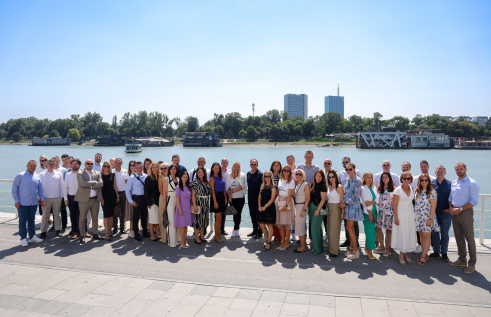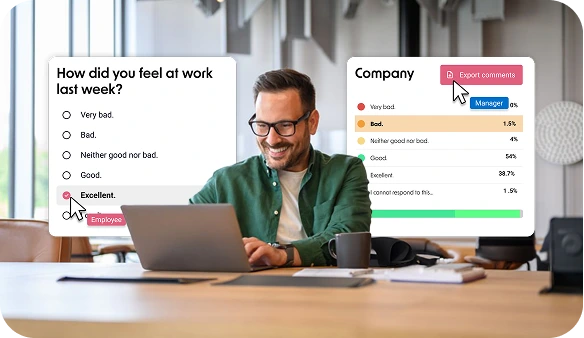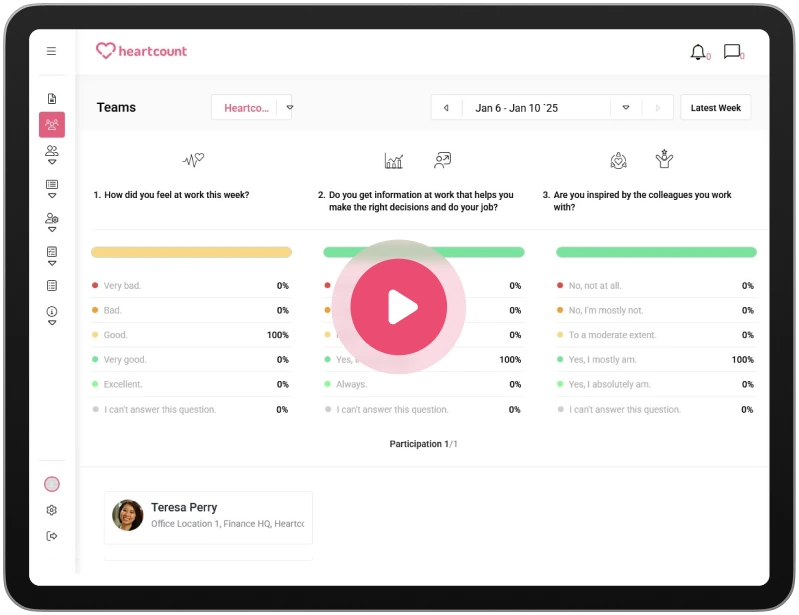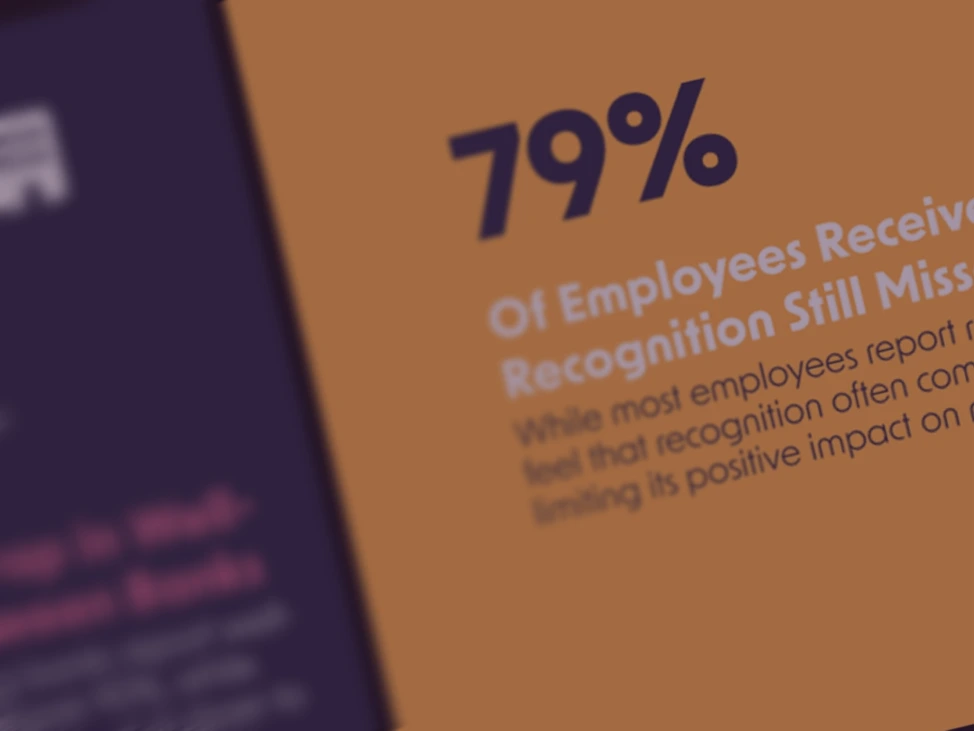Ultimate post-merger integration checklist for HR managers and directors

Mergers can be pretty stressful and uncertain time for your employees. Understandably, they’ll have a ton of questions and concerns.
Are they getting a new manager? Will they stay with the current team or move to a new one? Is the team culture going to stay the same? Will they become redundant and lose their job?
As a top executive or HR, you can help ease employees’ minds about what will happen after a merger or acquisition. The change will be significant, but here’s a post-merger integration checklist that will help make the whole process smoother for your employees.
-
1.What is post-merger integration (PMI)?
-
2.Types of M&A integration
-
3.Common challenges of post-merger integration
-
4.Post-merger integration checklist for HR managers and directors
-
5.How to implement tools and best practices to ensure successful integration?
-
6.Real-life examples of successful M&A integrations
-
7.Conclusion
Mergers can be pretty stressful and uncertain time for your employees. Understandably, they’ll have a ton of questions and concerns.
Are they getting a new manager? Will they stay with the current team or move to a new one? Is the team culture going to stay the same? Will they become redundant and lose their job?
As a top executive or HR, you can help ease employees’ minds about what will happen after a merger or acquisition. The change will be significant, but here’s a post-merger integration checklist that will help make the whole process smoother for your employees.
What is post-merger integration (PMI)?
Post-merger integration, or PMI, is a strategic process of combining and reorganizing companies following a merger or acquisition.
This process is the key to integrating different business units, systems, methods, and even company cultures while ensuring that business operations remain on track.
PMI is critical for achieving synergies and operational efficiencies and efficiently integrating systems, processes, and cultures.
Achieving synergies
Synergy happens when two entities (like companies) are combined in a way that increases their combined strength beyond the sum of their individual parts. Think of synergies as 1+1 = 3.
They can be:
- Cost synergies, which are realized through scaling, process optimization, or reducing redundant resources and roles or
- Revenue synergies, which happen through entering new markets, expanding product portfolio, or cross-selling
Operational efficiencies
Mergers also allow you to combine the best two entities, including their operational practices. This way, The new entity can improve its overall performance through the following:
- Improving processes by adopting lean those that take better advantage of the strengths of each entity
- Allocating resources and optimizing their use, thus capitalizing on economies of scale and reducing inefficiencies
Integrating processes and systems
Merging or combining two companies doesn’t happen magically. This requires:
- Migrating data to different systems
- Integrating technologies and adopting new solutions that support both entities in the long run
- Aligning processes and minimizing inefficiencies by identifying and implementing best practices from each entity
Integrating cultures
Finally, none of this will matter if the two company cultures clash. For instance, the 2000 AOL/Time Warner merger failed because of the clash of two cultures. On one side, you had a fast-paced, tech-driven Internet startup in AOL, and on the other, you had a traditional media juggernaut.
This part of post-merger integration is the most critical for employee experience. It directly affects employee morale by ensuring an inclusive environment and helping align the company’s values and goals.
Types of M&A integration
There are four different types of merger and acquisition integrations: complete, standalone, targeted, and functional. These depend on the strategic goals, compatibilities, and desired synergies.
Here’s a quick overview of all of them.
Full integration
Most people think about mergers this way: The two companies, the acquired and the acquiring, completely merge into a new company and start functioning as a new entity.
Pros
- One leadership, vision, and direction
- Maximum synergy
Cons
- Highly complex, expensive, and time-consuming
- Risk of cultural friction
Standalone integration
In this type of M&A integration, the integration happens mainly at the executive or strategic levels, and the acquired company remains relatively separate and independent from the acquiring company.
Pros
- The acquired company maintains its brand, operational structure, and culture (which can be crucial for preserving customer relationships)
- Lowers the risk of cultural clash
Cons
- Limits synergy opportunities that you would get from a full integration
- Managing two entities and aligning strategic objectives can be challenging
Targeted integration
Here, the acquiring company integrates only some areas of the acquired company but not all, thus leveraging specific strengths.
Pros
- The acquiring company can focus on the most valuable parts of the acquisition and ignore the less important ones.
- This also reduced disruption to operations
Cons
- Not realizing the full potential of the merger
- Creating operational silos
Functional integration
Finally, functional integration integrates only specific functions, such as HR, marketing, or finance, while the rest remain independent.
Pros
- Enabling function-specific synergies
- Maintaining the core business operation
Cons
- Partial integration can lead to poor operational alignment
- Employees in the integrated functions can find the new structure challenging, especially if there’s a change in leadership or processes
Common challenges of post-merger integration
Post-merger integrations can be complex, and several obstacles can prevent you from achieving the desired synergies and operational efficiencies.
The most common challenges include:
- Operational and integration challenges due to incompatible systems and technologies, misaligned processes, and supply chain disruptions
- Leadership problems, especially unclear decision-making, lack of leadership alignment, and no clear integration plan
- Due to different practices, financial and legal complexities can lead to regulatory issues, unforeseen liabilities, and financial misalignment.
- Market and customer impact: How will customers react to brand, product, or service changes?
- Synergy realization. Synergies are achieved through identifying opportunities, setting realistic goals, having a clear integration plan, and internal and external communication. If any of these fail, or you had a skewed view (i.e., you were too optimistic with goals), you won’t realize synergies.
PMI employee experience challenges
If we focus more on the employee experience during this process, the employees and the organization might find themselves struggling with the following:
- Cultural clashes
According to Deloitte, 30% of integrations fail because of cultural differences. Employees in one company might be used to doing things one way and those in the other company the other.
For instance, one company might have a very conservative structure and methods, while the other might be more modern and fast-paced.
On top of this, employees might resist the change if they think their culture is being brushed aside.
Clearly define what values the two organizations share and integrate the best of each into a new company culture.
- Adapting to new organizational norms
Mergers can bring new working methods, processes, protocols, and leadership dynamics.
Employees often find it challenging to adopt and accept new organizational norms, leading to confusion. For instance, a new manager might have a completely different style from the old one, which some employees might like less.
New leadership must communicate clear expectations and goals, especially regarding the company’s new direction.
- Maintaining employee engagement
Mergers often result in layoffs and higher turnover, leading to employee anxiety, especially when there is little to no communication.
It’s essential to be fully transparent about the merger and communicate with employees to ease their concerns. Additionally, providing career development opportunities and cleverly using employee surveys to gauge their feelings will help you maintain and even strengthen employee engagement during PMI.
- Poor or lack of communication
Communication during and following a merger must be at the highest level. Leadership and managers cannot send mixed signals to employees, or employees will get confused. Instead, everyone needs to speak with the same voice.
Employees also shouldn’t be kept in the dark. Transparency is often the key to them accepting the merger and understanding its reasoning.
Regularly update employees on the PMI progress, what decisions have been made, and why. Be fully transparent in communicating with them and ensure employees have someone to contact if they have any concerns.
Post-merger integration checklist for HR managers and directors
The process of merging two organizations into one unified entity is incredibly complex. You have to consider carefully:
- Actions to be taken
- Deadlines for each action
- The individuals/teams responsible for each task
- Milestones to mark the progress
A PMI checklist will help you stay on track, including managing staff transition, addressing regulatory requirements, and integrating technology. This will minimize disruptions, optimize resources, and increase the chances of a successful merger.
Here is a sample checklist for HR directors and managers that you can adapt depending on your organization’s specific needs:
- Evaluate company cultures
- Conduct cultural assessment through employee surveys, stay interviews, and focus groups on understanding the two companies’ values, behaviours and practices.
- Create a merging cultures strategy
- Develop a culture integration plan (CIP) that will align with business objectives.
- Communicate vision
- Develop and execute a communication plan to explain the merger’s vision and goals to employees through different communication channels, ensuring inclusion and transparency.
- Include leadership in modelling behaviours
- Everyone should participate in integration activities, including leaders who can set a positive example for employees.
- Promote employee engagement
- Provide opportunities for employees to offer feedback (i.e., in meetings or through surveys) and update them regularly on the integration progress.
- Offer training programs
- Offer training and development programs for employees to learn about the new systems, processes, and expectations.
- Provide learning programs for employees to develop new skills.
- Include mentorship programs to make the transition easier for employees.
- Establish KPIs to monitor and track progress
- Establish key performance indicators (KPIs) to measure employee engagement, retention performance metrics, and more.
- Review KPIs regularly.
How to implement tools and best practices to ensure successful integration?
Implementing the right tools and best practices can turn a shaky M&A into a successful one. To ensure a smooth transition, the focus should be on:
Communication channels
Communication channels include different platforms that enable seamless information sharing and interaction between employees, managers, customers, partners, and other stakeholders.
- Multi-channel communication platforms centralize individual communication channels (email, chat, social, etc. into one interface and enable interaction. As a result, it becomes easier for employees from both companies to access the information they need, get updates, and align teams across the board.
- Instant messaging (IM) and chat tools like Slack facilitate real-time employee communication. As different day-to-day operational problems often arise during the integration process that may disrupt the workflow, quick and real-time communication that IM tools enable becomes essential.
- Video conferencing tools such as Zoom enable face-to-face meetings and help remote teams. This face-to-face interaction is also vital for establishing trust between the teams.
- Email communications platforms like Gmail or Microsoft Office enable formal communication and newsletters. As the go-to channels for officially documented communication, email platforms ensure that everyone is on the same page during and after the merger and can receive important company-wide announcements, updates, or guidelines.
- Social media management tools help increase engagement and brand presence by managing and integrating social media interactions with external stakeholders. They also allow the two companies to communicate their joint vision.
Feedback platforms
Tools that collect and analyze different employee and customer feedback and provide insight for continuous improvement and fostering an open communication culture
- Survey and polling tools are platforms used to collect employee feedback, assess their satisfaction or loyalty, and identify areas for improvements in employee engagement. In a PMI context, these tools give leaders and HR managers insight into how employees feel about the integration, their thoughts, concerns, and their struggles.
- Feedback management systems include tools for aggregating and analyzing feedback collected from multiple sources. This is very valuable in understanding and tracking trends and areas of concern during the integration process and making informed decisions.
- Employee engagement platforms, like HeartCount, enable employees to share their feedback, opinions, or sentiments regarding company culture, practices, etc. Having a space that will ensure employees feel valued and connected, even during these changes, is vital.

Employee engagement and experience software
Platforms that are used to improve employee satisfaction, productivity, and organizational goal alignment
- Employee experience platforms help boost employee experience by incorporating feedback mechanisms and engagement training. EEPs are important for understanding and monitoring how the integration is affecting employees.
- Recognition and rewards platforms enable employee recognition programs and boost employee morale and satisfaction. Managers can use these platforms to recognize an employee who has gone above and beyond to contribute to the success of the integration.
Training and development tools
Software solutions that support employees in skill development, career growth, and knowledge sharing help them adapt and contribute to the integration process.
- Learning management systems (LMS) include software that provides training programs and development frameworks. These systems can be used to offer courses tailored to specific integration needs, such as company culture training.
- E-learning platforms are online platforms that offer paid or free courses and training materials, like LinkedIn Learning. Similarly to learning management systems, e-learning platforms can also be used to provide tailored courses that employees can complete at their own pace and remotely.
- Onboarding software includes tools designed to streamline the onboarding process for new employees. This can especially be valuable for employees from the acquired company, who will need help adapting to the new company structure and culture.
- Performance management tools help track employee performance and development and provide insights for future training needs. These tools help managers set clear expectations for new employees and track their progress, ensuring everyone is aligned with the new processes.
Culture and values alignment tools
Are platforms that gauge the organizational culture, values, and behaviours and align them with the integration objectives.
- Culture assessment tools assess the organizational culture and employees’ alignment with company values and provide insights for improving company culture. By understanding any cultural similarities and differences, managers can discover potential areas of conflict and make informed decisions on how to blend the cultures effectively.
- Diversity and inclusion tools include software that aids the organization in improving its diversity and inclusion. These tools are vital in a situation where two merging companies are coming from different geographies (for example, Asia and Europe) or industries, as they can help address biases and identify groups that are not represented adequately.
Analytics and reporting tools
Include software used to analyze employee engagement levels, performance, retention, job satisfaction, and other data and help the organization make data-driven decisions.
- People analytics software analyzes employee data and provides insights into engagement levels. This type of software allows organizations to explore employee data and identify trends, such as employee engagement levels, turnover rates, etc., during integration and make informed decisions to ensure a successful integration.
- The engagement metrics dashboard compiles and visualizes vital engagement metrics. It provides leaders and managers with a helpful tool for gaining insight into how employees feel about the integration and whether they need any support.
With HeartCount, you can quickly assess team dynamics, identify any immediate concerns, and maintain momentum through weekly snapshots of employee engagement. Real-time reports are always accessible and automatically updated on the platform based on your employees’ activity throughout the week.
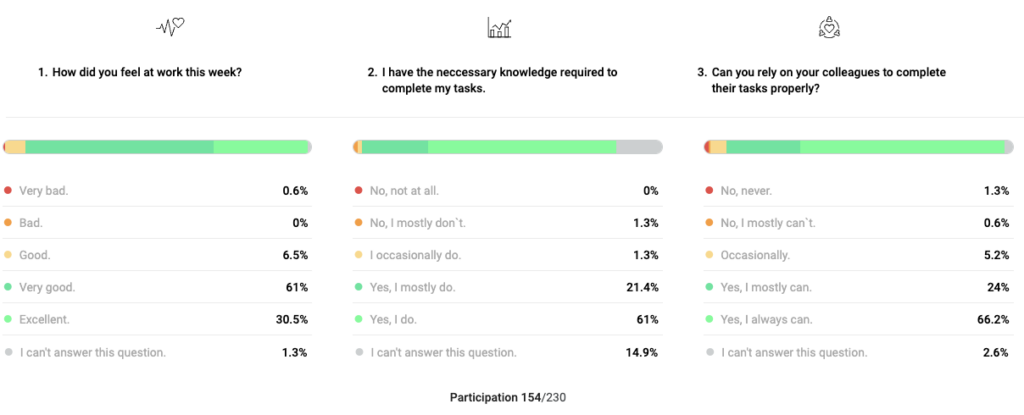
Real-life examples of successful M&A integrations
NLB and Commercial bank
Realizing that the lack of cultural integration is one of the top reasons for failed mergers and acquisitions, NLB Bank turned to HeartCount to manage its cultural integration following its merger with Commercial Bank.
The new company, NLB Commercial Bank, aimed to build a joint culture based on open communication and feedback. The challenge was how to prevent employee dissatisfaction caused by clashing cultures.
The new strategy focused on understanding and monitoring employee engagement at all levels to prevent this possibility. In an organization with 2,000+ employees, this ruled out one-on-one meetings.
Fortunately, as a HeartCount client, NLB bank was already familiar with PulseCheck surveys and has used them regularly, so they could collect feedback more efficiently and even earn an international Top Employer Certificate in 2024.
2006 Disney and Pixar
Disney’s 2006 acquisition of Pixar was a prime example of how cultural alignment, leadership continuity, and a clear vision can lead to success.
The biggest fear at the time was that Disney’s more corporate culture would swallow up Pixar’s creative culture. Luckily, Disney recognized the need to preserve Pixar’s operational independence.
This wouldn’t have been possible without maintaining leadership continuity. Instead of bringing in new management and potentially breaking what was already working just fine, Pixar’s creative leaders, Ed Catmull and John Lasseter, remained at the company’s helm. This helped avoid cultural clashes, as Pixar employees had familiar faces to lead them.
Finally, the deal was a win for both sides. Disney could enjoy Pixar’s unmatched creativity, and Pixar could leverage Disney’s huge platform to further its reach.
2012 Facebook and Instagram
“If it ain’t broken, don’t try to fix it.”
In short, this could summarize why the 2012 Facebook acquisition of Instagram was such a success.
It would probably have been easy for Facebook, which was at the top of its game then, to buy Instagram and just offer it as one of its products like Messenger, but that didn’t happen. Instead, Instagram remained a standalone brand and kept its team structure. Without this, IM could not retain its unique user experience.
Of course, now that they had Facebook’s financial and marketing backing, Instagram “exploded” from a company with 13 employees and 30 million monthly active users (MAU) in April 2012 (just before the merger) to 100 million MAU in December 2012 (six months after). Already in 2014, Instagram had 200 million MAUs; in 2018, it surpassed 1 billion, and in 2022, it reached 2 billion MAUs.
Conclusion
The success of a merger or acquisition often rests on whether the employees will accept it or not. This makes it crucial for HR directors and managers to ensure a seamless post-merger transition for employees.
Want to find out how our platform can ensure the success of your post-merger integration?



